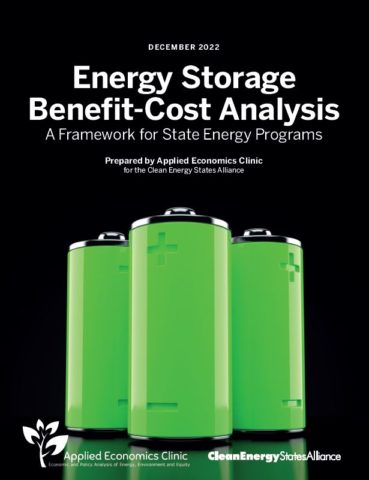Energy Storage Benefit-Cost Analysis: A Framework for State Energy Programs
December 13, 2022
Applied Economics Clinic | Clean Energy States Alliance (CESA)
This report provides a framework for state energy agencies contemplating a benefit-cost analysis (BCA) for battery storage. It was prepared by Applied Economics Clinic for the Clean Energy States Alliance.
Battery storage is a particularly difficult technology to assess with a BCA, for several reasons. For one thing, batteries are a multi-use resource, meaning that they can do lots of different things depending on decisions made by the user: for example, they can act as a generator or as a load, or as a transmission or distribution grid resource. Additionally, some of the benefits of battery storage, such as resilience, are hard to quantify with a dollar value, while other battery services are difficult to monetize in power markets, either because open markets do not yet exist (as with resilience) or because storage doesn’t qualify to enter the market (for example, in jurisdictions where distributed resources cannot easily bid into wholesale capacity markets).
Aside from these issues, there are many nuts-and-bolts questions to be answered: Which of many available cost-effectiveness tests are most appropriate for battery storage? What discount rate should be used? and How should states conduct a BCA process to ensure the results are both fair and equitable? States may be uncertain about how to answer these questions, for the simple reason that batteries are not a technology with which they have much prior experience.
This report is intended as a guide for state energy agencies preparing to conduct cost-effectiveness evaluation for battery storage. It presents a BCA framework for battery storage and attempts to address many of the uncertainties state energy agencies may encounter. The report is based on best practices gleaned from numerous BCAs undertaken by early adopter states, as well as related literature about how to value battery services.
This report was conducted by Applied Economics Clinic on behalf of and with input from the Clean Energy States Alliance. It should provide guidance that will be useful for many state and municipal energy agencies across the United States.





